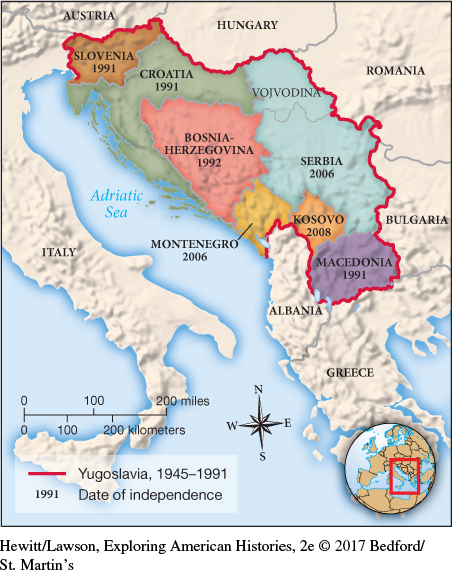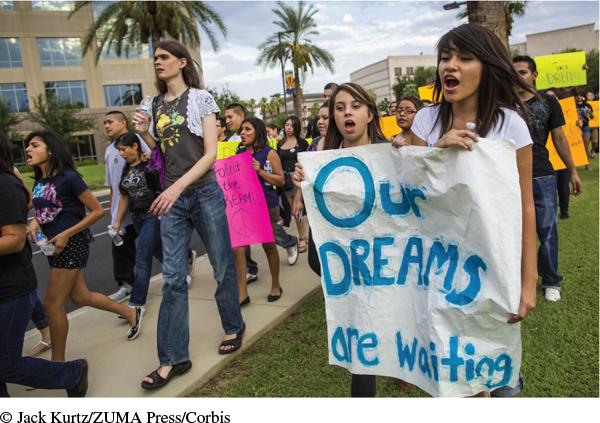An Unfinished Agenda around the World
Throughout Obama’s two terms, his administration faced serious tests of its international leadership. In 2008 the president had appointed Hillary Clinton, the former First Lady and a senator from New York, as his secretary of state. The U.S. military increased combat troop withdrawals from Iraq and turned over security for the country to the newly elected Iraqi government. At the same time, the Obama administration stepped up the war in Afghanistan by increasing U.S. troop levels, which led to a rise in casualties. Then in 2011, he achieved a dramatic success when U.S. special forces killed Osama bin Laden in his hideout in Pakistan. By 2016, with John Kerry now his secretary of state, the president had withdrawn most combat soldiers from Afghanistan. Yet Iraq remained unstable in the absence of a strong American military presence, and the outcome of the war against the Taliban in Afghanistan remained uncertain. Despite bin Laden’s death, radical jihadists continued to pose a serious danger.

Other international challenges continued as well. From 2006 to 2013, a hostile North Korea tested a series of nuclear weapons. During this period, instability in other parts of Asia, the Middle East, and the Persian Gulf also heightened U.S. security concerns and underscored the difficulties of achieving lasting peace in these regions (Map 29.2).

In 2011 the situation briefly looked more hopeful. In a period known as the Arab Spring, great changes swept across the Middle East, as young people, armed mainly with cell phones and connected through social media networks, peacefully toppled pro-Western but despotic governments in Egypt and Tunisia and convinced the leader of Yemen to step down. In Libya armed rebels succeeded in overthrowing the anti-American dictator Muammar al-Qaddafi.
However, many of these changes in the Middle East did not last. The military returned to power in Egypt, and civil war consumed Libya and Syria. Even more dangerous was the rise of a new militant organization in the region known as the Islamic State of Iraq and Syria (ISIS), an offshoot of al-Qaeda that grew out of the sectarian violence following the overthrow of Saddam Hussein in Iraq. ISIS took over parts of Syria and Iraq, prompting the United States and some Arab nations to launch air strikes against its forces.
The ongoing civil war in Syria had profound effects on the rest of the world. Starting in 2010, millions of Syrians fled their homes, and tens of thousands sought refuge in western Europe and the United States. This movement of refugees, which is greater than at any time since World War II, overwhelmed those European countries to which they first came—Greece, Hungary, and the Czech Republic. Hungary constructed fences to stop the flow of migrants, while the EU split over how to manage the crisis. In 2015 President Obama pledged to accept 10,000 additional Syrian refugees into the United States during 2016, but that number paled in comparison to the numbers who needed safe havens. Meanwhile, the humanitarian crisis of providing food, shelter, and medical attention to the refugees remained largely unresolved.
At the same time, little was accomplished in resolving the Palestinian-Israeli conflict. Despite considerable effort, the Obama administration failed to broker a peace agreement between the two antagonists. In 2014 Israeli troops invaded Gaza after the Hamas government launched rockets into Israel. Resulting in the deaths of more than 2,000 Palestinians, most of them civilians, the war only increased tensions between the two sides.
From the outset of his first term in 2009, President Obama fought the war against terror by stepping up the use of remote-controlled armed drones (unmanned, aerial vehicles) against al-Qaeda and ISIS leaders in Pakistan, Afghanistan, Yemen, and Somalia. Although some top terrorist leaders were killed, drone attacks also resulted in significant civilian deaths.
At home, antiterrorist surveillance provoked growing controversy. Under the Patriot Act, the National Security Agency (NSA) began collecting and storing phone records of U.S. citizens. The NSA did not listen to the calls, but it drew on this bulk data to track suspected terrorists. The existence of this massive, clandestine operation came to light in 2013, when Edward Snowden, an intelligence analyst contracted by the NSA, leaked the information to the Guardian newspaper before seeking refuge abroad. In doing so, he ensured public scrutiny of the balance between national security and individual privacy. Snowden’s revelations led Congress to pass legislation curtailing this practice in 2015.
On other foreign issues, President Obama launched bold departures. In 2014 he set in motion the normalization of diplomatic relations with Cuba and, the following year, along with several other world powers, negotiated an agreement with Iran on restricting its nuclear program. In contrast, relations with Russia deteriorated. In 2014 Russia, led by Vladimir Putin, annexed its former territory of the Crimea and in 2015 provided military support for pro-Russian separatists in Ukraine. In response the United States and the EU imposed economic sanctions on Russia but declined to take military action. Later in 2015 Russia sent military forces to Syria to support the government of the dictator Bashar al-Assad, a long-time ally, and fight his opponents, both ISIS and rebels backed by the United States. The presence of U.S. and Russian aircraft flying military operations over Syria escalated tensions between the United States and Russia and raised prospects of a confrontation between them.
The United States faced global economic and environmental challenges as well. As China flourished economically, American workers lost jobs, and the Chinese amassed a nearly $200 billion trade surplus with the United States. In addition, the growth of manufacturing and the market economy in China resulted in the rising consumption of oil and gasoline. The increase in carbon emissions in China and other parts of Asia contributed to the problem of climate change, which ultimately threatens the survival of the planet. Global warming during the twentieth century resulted mainly from emissions of greenhouse gases into the atmosphere and the erosion of the ozone layer. As temperatures climb, they cause the melting of glaciers, a rise in the sea level, extreme fluctuations of weather with severely damaging storms, and famines. Disruptions in industrial and agricultural production caused by storms and the subsequent expense of rebuilding have had a negative impact on the U.S. and world economies. Recognizing the increasing dangers of global warming, in December 2015 the United States joined 194 nations, including China and India, and agreed to reduce greenhouse gas emissions produced from fossil fuels.
In the context of international debates over terrorism, refugees, and global warming, controversies continued in the United States over immigration. Immigration restrictionists, particularly in Arizona and Texas, support such policies as building a fence along the U.S.-Mexican border and strengthening border security. Supporters of immigration reform favor opening up a path to citizenship for illegal residents who have lived in this country for a designated period and have jobs. However the immigration issue is resolved, by the end of the twenty-first century the population of the United States will look much different than it did at the beginning. In 2012 the U.S. Census Bureau reported that nonwhite babies made up the majority of births for the first time. If the current trends in immigration and birthrates continue, the percentage of Latinos and Asian Americans in the nation will increase, while that of whites and blacks will decline. In addition, the racial and ethnic composition of the population has been transformed through intermarriage. In 2010 the Census Bureau reported that one of seven new marriages, or 14.6 percent, was interracial or interethnic. In 1961, when Barack Obama was born, the figure for interracial marriages was less than 0.1 percent. Thus, in an increasingly globalized nation, debates over immigration, race, and citizenship have taken new forms and significance.

REVIEW & RELATE
What were the causes and consequences of the Great Recession?
What effects did the election and presidency of Barack Obama have on American politics, society, and the United States’ relationship to the world?
Exploring American HistoriesPrinted Page 990
Exploring American Histories Value EditionPrinted Page 732
Chapter Timeline